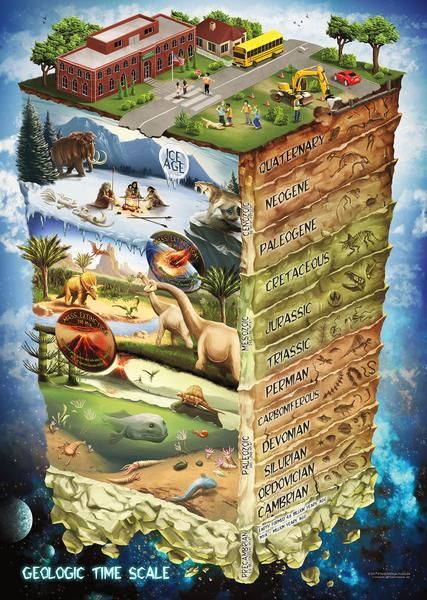If you are passionate about fossil hunting and geology on The Yorkshire Coast this very simple guide is probably not for you (but feel free to share your passion with us). This guide is intended for those of you who are new to the subject. Maybe you’ve sometimes picked up a rock and looked at the strange patterns on it and just wondered ‘What made this?” or “How did this get here?” and “Why are there so many of them on The Yorkshire Coast?”
If that’s you, read on…
Let’s start with a diagram, it is really hard to get our heads around how really old the earth is – and just how long ago dinosaurs roamed the earth. I think this diagram really helps to visualise this and shows in a very simple way how the layers of rock have been laid down over the many years.

William Smith (1769–1839) pioneered the theory of using fossils to map rocks. He showed that rock types could repeat themselves but fossils did not. It was a hugely significant find – it basically meant that he was able to map where you were likely to find coal, oil and other natural minerals just by identifying the type of rock and the fossils found in that area. He even made a map showing all the rocks to be found in the UK. He did most of this while he was working for Scarborough Philosophical Society, which set up the Rotunda Museum. The layers of rock he could clearly see on the Castle headland helped with his findings and his theories are still the principles behind modern geology and are being used in the mining/oil industry today.
So what makes The Yorkshire Coast so unique?
In very simple terms the way the sea has eroded the cliffs has revealed the many fossilised remains of the Jurassic rocks found here. The Jurassic period was pretty eventful over its 55 million years (200 – 145 million years ago).
The way these rocks have been revealed over time shows the older (Lower Jurassic – 190 million-year-old) rocks in the northern end at Staithes down to Whitby – giving us Whitby jet which has long been thought to be from ancient trees. But is it? Find out more at this talk at the Fossil Festival on 18 September.
In Scarborough you can see the Middle Jurassic 150 – 165 million-year-old rocks. This is where we find lots of dinosaur footprints because sea levels had fallen and the area was covered in river channels and swamps.
Further south you can see the Upper Jurassic rocks of around 150 million years old at Filey Brigg. The Jurassic – Cretaceous boundary is somewhere in Filey Bay. Once we move down to Speeton and Reighton and further south we move into the Cretaceous period. Here the sea levels had risen again leaving remains of ancient sea creatures.

Similar fossils can be found on the coast around Filey Brigg.
https://www.flickr.com/photos/liamherringshaw
The amazing thing is, anyone can find a little bit of this ancient history on our beaches – here’s a great guide for fossil hunting on the Yorkshire Coast: https://thefossilshop.co.uk/blogs/blog/top-10-fossil-hunting-tips.
But if you really want to immerse yourself in the subject – come and chat to world-leading experts and see this amazing Jurassic history brought to life then you really do not want to miss the Yorkshire Fossil Festival on 17 & 18 September in Scarborough, based at Scarborough Spa and other locations around the town.







